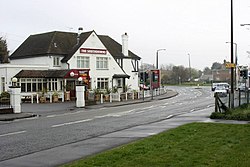Felpham
| Felpham | |
| Sussex | |
|---|---|
 The B2259/B2132 junction | |
| Location | |
| Grid reference: | SZ949998 |
| Location: | 50°47’26"N, -0°39’14"W |
| Data | |
| Population: | 9,746 (2011) |
| Post town: | Bognor Regis |
| Postcode: | PO22 |
| Dialling code: | 01243 |
| Local Government | |
| Council: | Arun |
| Parliamentary constituency: |
Bognor Regis and Littlehampton |
| Website: | http://www.felphampc.gov.uk/ |
Felpham is a village in Sussex, attached to the townscape of Bognor Regis. This village had a recporded population of 9,746 at the 2011 census. It is along the B2259 coastal road.
Church
The parish church, St Mary's, is of the 12th century.[1][2] It stands on the site of an earlier, Saxon church, which was pulled down to be replaced by the church of today in around 1100. A hundred years later, the church was extended with the addition of a north aisle, and a south aisle awas added around 1300.
The font, of Wealden marble, may be contemporary with the church, from 1100.
There is also a Methodist church close to the three-way junction of Felpham Way, Flansham Lane and Middleton Road, in the east of the village.
History
Felpham is mentioned in a charter of 953 by which King Eadred granted thirty hides of land there to his mother Queen Eadgifu.[3] It is mentioned in the Domesday Book of the 11th century, under the hundred of Binstead: "St Edward's Abbey [Shaftesbury] holds and held Felpham before 1066..." Its value before 1066 was said to be £10.[4][5]
The poet William Blake was introduced to the village by his friend William Hayley and lived in Felpham for three years between 1800 and 1803.[6] He wrote Milton: A Poem in Two Books, while living in a house now named Blake's Cottage. The poem contains the line about "England's green and pleasant land", today known as the song "Jerusalem", which were inspired by Blake's "evident pleasure" in the Felpham countryside.[7] The cottage where he lived is depicted in the illustrations for the poem. It lies within the original village, close to the Fox public house. Of the village he wrote:
Away to sweet Felpham for heaven is there:
The Ladder of Angels descends through the air
On the turrett its spiral does softly descend
Through the village it winds, at my cot it does end.
The "turrett" in the verse is Hayley's house, east of the church, which he built around 1800. It was in Felpham that Blake had his altercation with the drunken soldier John Scofield, who was trespassing in his garden.[2] This led to Blake's trial for sedition because of Scofield's allegation that he had cursed the king. Blake has a road named after him, Blake's Road, the road on which his former residence is sited, and a memorial window dedicated to him in St Mary's Church.
Blake's host, Hayley, was also famous in his day for having turned down the offer of the position of poet laureate in 1790.
The village has a village hall, called the Memorial Hall, built in remembrance to the fallen from the First World War and a church community hall called St Mary's Centre.
Due to the 1960s redevelopment, Peartree Cottage in Vicarage Lane is now the oldest house in Felpham. It is a late mediæval (c. 1500), four bay, timber-framed thatched Yeoman's house with queen struts and clasped side purlins. It had an open first bay, (probably a workshop) and still has an intact smoke bay. In the 1700s the house was 'modernised' with the insertion of a chimney built within the smoke bay and three exterior walls replaced with flint with rubble infill. Peartree has a small Victorian extension faced with galleted knapped flint. Two small bays were added to the south face of the house in the early 1900s.
In the 1940s the house was owned by the Jagger family, namely David Jagger (1891-1958). He and his siblings, Edith Jagger (1880-1977) and Charles Sargeant Jagger (1885-1934) were all celebrated artists. Charles's best friend was fellow artist Augustus John (1878 - 31 October 1961) who may well have visited Peartree because carved into one of the sagging jowl posts is the image of a bearded man who looks uncannily like the young Augustus John
Great expansion of the village took place between 1930 and 1960 when three (nominally) gated housing estates were developed, and again in the 1970s when two public housing developments took place on farmland between Felpham and its neighbouring village of Middleton-on-Sea. In December 2006 planning permission was granted for further development, this time on farmland to the north.
Sport and leisure

Felpham has a recreation ground, King George's Field.
- Football:
- Felpham Colts Football Club
- Predators Youth
- Gymnastics: Arun Gymnastics Club
The Felpham & Middleton Country Dance Club is one of the oldest extant country dance clubs in Britian.
Felpham Church Hall was also the starting point for the 2008 Scout Overland Hike.
Outside links
| ("Wikimedia Commons" has material about Felpham) |
References
- ↑ St Mary's, Felpham
- ↑ 2.0 2.1 Nikolaus Pevsner: The Buildings of England: Sussex, 1965 Penguin Books ISBN 978-0-300-09677-4page 219
- ↑ Kelly, Susan, ed (1996). Charters of Shaftesbury Abbey. Anglo-Saxon Charters. Oxford, UK: Oxford University Press for the British Academy. pp. 70-72 (charter S 562). ISBN 978-0-19-726151-4.
- ↑ Morris, John, ed (1976). History from the Sources: Domesday Book : Sussex. Chichester: Phillimore. p. 8a–9. ISBN 0-85033-145-5.
- ↑ Felpham in the Domesday Book
- ↑ National Heritage List 1353792: Blake's Cottage (Grade II* listing)
- ↑ Amanda Gilroy, Green and Pleasant Land: English Culture and the Romantic Countryside, Peeters Publishers, 2004, p. 66.
